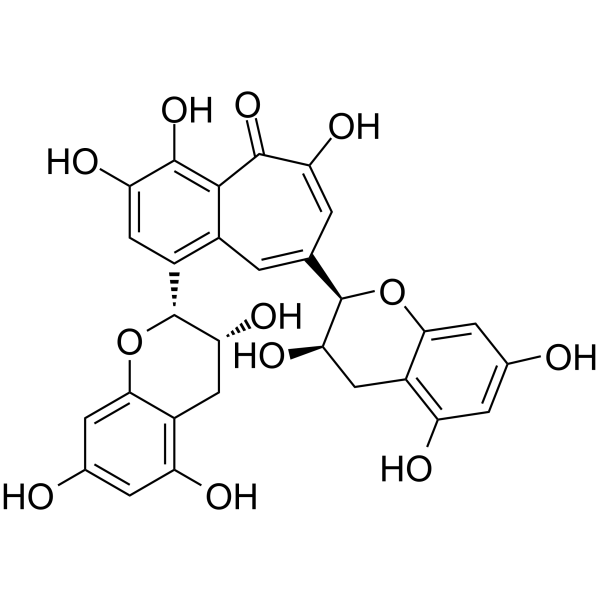All AbMole products are for research use only, cannot be used for human consumption.

Theaflavin is a natural influenza A (H1N1) neuraminidase inhibitor. Theaflavin is a polyphenolic flavonoid that has been found in black tea and has diverse biological activities, including antioxidant, anticancer, anti-inflammatory, and antiviral properties.
| Cell Experiment | |
|---|---|
| Cell lines | OBA-9 cells |
| Preparation method | OBA-9 cells were treated with the black tea extract (150 and 200 μg/ml), theaflavin (75 and 100 μg/ml), theaflavin-3,3’-digallate (75 and 100 μg/ml) or EGCG (100 μg/ml) for 48 h at 37°C in a 5% CO2 atmosphere. Following stimulation, the supernatants were collected, centrifuged (500 x g for 5 min) and stored at -80°C until used. |
| Concentrations | 75 and 100 μg/ml |
| Incubation time | 48 h |
| Animal Experiment | |
|---|---|
| Animal models | nude mice |
| Formulation | PBS |
| Dosages | 10 mg/kg/d |
| Administration | i.v. |
| Molecular Weight | 564.49 |
| Formula | C29H24O12 |
| CAS Number | 4670-05-7 |
| Form | Solid |
| Solubility (25°C) | DMSO 30 mg/mL |
| Storage |
Powder -20°C 3 years ; 4°C 2 years In solvent -80°C 6 months ; -20°C 1 month |
| Related Anti-infection Products |
|---|
| Strictinin
Strictinin is a phenolic compound which has potential antiviral, antibacterial and laxative activities. Strictinin occurs by accelerating intestinal transit rather than enhancing gastric emptying, increasing food intake, or inducing diarrhea in rats. |
| Torcitabine
Torcitabine (2'-Deoxy-L-cytidine) is an antiviral agent. Torcitabine has the potential for chronic hepatitis B virus infection research. Torcitabine (2'-Deoxy-L-cytidine) shows greater inhibition of first strand than second strand DNA synthesis. |
| ABMA
ABMA is a broad-spectrum inhibitor of intracellular toxins and pathogens. ABMA efficiently protects cells against various toxins and pathogens including viruses, intracellular bacteria and parasite. |
| DDX3-IN-1
DDX3-IN-1 is a DEAD-box polypeptide 3 (DDX3) inhibitor with CC50 values of 50 and 36 μM for HIV and HCV, respectively. DDX3-IN-1 has antiviral activity. |
| WU-04
WU-04 is a non-covalent inhibitor of SARS-CoV-2, targeting the 3CLpro protein. |
All AbMole products are for research use only, cannot be used for human consumption or veterinary use. We do not provide products or services to individuals. Please comply with the intended use and do not use AbMole products for any other purpose.


Products are for research use only. Not for human use. We do not sell to patients.
© Copyright 2010-2024 AbMole BioScience. All Rights Reserved.
